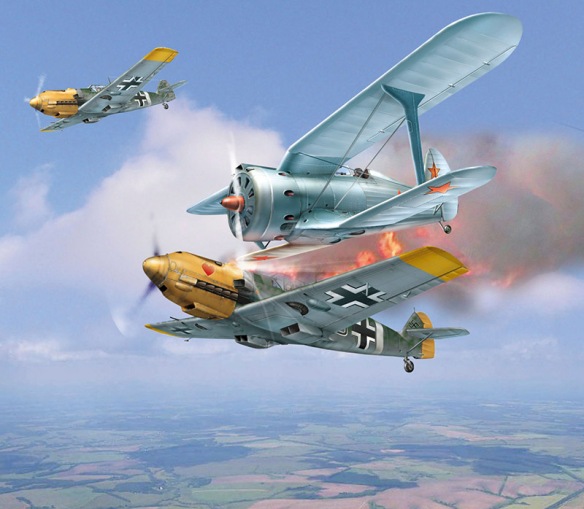Officially, the Russian orders on ramming (in Russian, taran) were taken off the books in September 1944. By that time Russian pilots dominated the skies and few Luftwaffe planes ventured outside German skies. But the evidence shows that wartime ramming was still possible and enforceable 15 years after the war; when Russian commanding officers could still give orders to initiate a ram attack, a tactic that often killed the pilot attempting it. There is the notorious case of May 1960 when a high-altitude American U-2 spy plane was spotted over Siberia. In a little-known sidelight, a Russian Air Force major was ordered to take off and ram the intruder. Although the pilot became airborne, he never made contact with the American U-2 which, he says, probably saved his life. Hit by a missile, the US plane crashed, its pilot, Francis Gary Powers, parachuting to safely. The order to ram the intruder was not made public until three decades after the event.
The first rammings took place during the very first hours of the invasion when Russian pilots stopped a number of incoming German planes by crashing into their wings or fuselage, sending them corkscrewing out of the sky. Each ram attack involved exceptional courage and great skill. In his popular wartime novel, The Living and the Dead, the author Konstantin Simonov has a character say, after hearing that a Luftwaffe plane was rammed over Moscow: `Fancy smashing into another plane like that!’ In reply, someone says the Luftwaffe have become less bold than previously; that the rammings had scared the German pilots.
There was some truth in this. On the opening day of invasion, six Russian pilots, having spent their ammunition, rammed Nazi planes, causing them to crash in flames. Hermann Goering’s pilots who learned about the rammings could be excused if these reports raised an involuntary shiver.
A terse radio broadcast from Moscow announced the first ramming: `At 05.15 hours on June 22, 1941, about 200 miles inside Russian territory, Flight Leader Junior Lieutenant Leonid Butelin rammed a German Junkers-88 bomber, severing its tail with the propeller of his fighter. This is the first ramming of the war.’
Rammings were supposed to be an expedient of last resort for Russian pilots. The Luftwaffe was all-powerful in the first weeks and months of the invasion and Russian air power was no match for it. German planes were generally superior and their pilots had the advantage of previous combat experience. But there was no shortage of Russian daring. In the meantime, Russian pilots absorbed the tactics of ramming and some of them not only survived but went up and rammed again.
Russian wartime directives actually spelled out when pilots had to ram enemy planes. For example, a Combat Directive issued to the pilots of the 6th Air Corps during the defence of Moscow said: `If machine guns jam in the air, if cartridges are spent prematurely, if the enemy is out to destroy an important state object, go and destroy the enemy by ramming.’
Here is how the Chief Marshal of the Soviet Air Force, A. A. Novikov, regarded the act of ramming: `Any technique of air combat demands valour, courage and skill by the pilot. But a ram attack makes incalculably greater demands on a pilot. Ramming means, first of all, a readiness for self-sacrifice; it is a test of loyalty to the people, to the ideals of the Motherland.’ Novikov went on to call ramming `one of the highest forms of displaying a high morale that is inherent in the nation’. But he also spoke of the importance of ramming in the purely tactical sense. Looking back after the war, he said: `The enemy pilots’ fear of ramming gave our pilots advantages such as manoeuvring possibilities, and helped boost their growing superiority in air combat tactics.’
According to this directive, pilots were not being sent on suicide missions: `To ram the enemy is an act of the greatest heroism and bravery but is not an act of self-sacrifice.’ The directive added the injunction: `You should know how to ram.’ There followed four pages on the techniques of ramming. Pilots who had rammed enemy aircraft early in the war and survived taught others this `act of total aggression’ in the sky. The official reports said that ramming fatalities to Russian pilots were mainly the result of head-on collisions. Pilots survived, said the reports, if they were able to bale out or if they managed to land their damaged planes. Not mentioned was the detail that if and when both planes became uncontrollable after a ramming, their pilots were usually doomed.
The air ace Alexander Pokryshkin, who shot down 59 Nazi planes, and became an air marshal after the war, gave this opinion of the wartime directives that imposed ramming as a duty: `Everything is correct; it was just like that. A strike by ramming is the weapon of fliers with iron nerves. In the defence of Moscow this method was rightly necessary.’ Pokryshkin added:
At short distances, behind the tail of an enemy bomber, our fighter was invulnerable. He got into the `dead cone’ of enemy fire, inched closer and cut off a section of tail, or a wing. One Nazi flier who bailed out after his bomber was rammed, said when interrogated: `Rumours went around about rammings on the Eastern Front. But at first we did not believe in them. What a terrible thing it is!’
